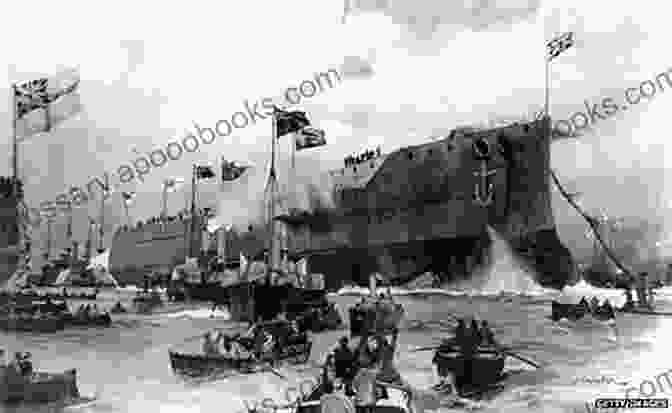The Great Dreadnought Race: Brazil, Argentina, and Chile's Quest for Naval Supremacy

During the early 20th century, the navies of Brazil, Argentina, and Chile engaged in a fierce rivalry to acquire the most powerful battleships, known as dreadnoughts. This 'Great Dreadnought Race' had a profound impact on the military balance of power in South America and beyond.
4.4 out of 5
| Language | : | English |
| File size | : | 18049 KB |
| Text-to-Speech | : | Enabled |
| Screen Reader | : | Supported |
| Enhanced typesetting | : | Enabled |
| Word Wise | : | Enabled |
| Print length | : | 87 pages |
| Paperback | : | 96 pages |
| Item Weight | : | 10.8 ounces |
| Dimensions | : | 6.5 x 0.25 x 9.25 inches |
The Birth of the Dreadnought
The dreadnought was a revolutionary type of battleship that emerged in 1906 with the launch of HMS Dreadnought by the Royal Navy. Dreadnoughts were characterized by their all-big-gun armament, which consisted of a uniform battery of heavy-caliber guns. This gave them a significant advantage over older battleships, which had a mixed armament of guns of various sizes.
The launch of HMS Dreadnought sparked a global arms race, as navies around the world rushed to build or acquire dreadnoughts of their own. Brazil, Argentina, and Chile were no exception.
The South American Dreadnought Race
The South American dreadnought race began in 1907, when Brazil Free Downloaded two dreadnoughts from the British shipyard Armstrong Whitworth. These ships, Minas Gerais and São Paulo, were the first dreadnoughts to be built in South America.
Argentina and Chile quickly followed suit. In 1909, Argentina Free Downloaded two dreadnoughts from the United States, Rivadavia and Moreno. Chile, not to be outdone, Free Downloaded two dreadnoughts from the United Kingdom, Almirante Latorre and Almirante Cochrane.
The construction of these dreadnoughts was a major undertaking for all three countries. They were the most expensive and technologically advanced warships ever built in South America. The dreadnoughts also required a significant investment in infrastructure, such as new docks and repair facilities.
The Impact of the Dreadnought Race
The Great Dreadnought Race had a profound impact on the military balance of power in South America. The acquisition of dreadnoughts gave Brazil, Argentina, and Chile a significant advantage over their neighbors. The dreadnoughts also gave these countries a greater voice in international affairs.
However, the dreadnought race also had a negative impact on the economies of Brazil, Argentina, and Chile. The construction and maintenance of these ships was a major financial burden. The arms race also diverted resources away from other areas, such as education and healthcare.
The Legacy of the Great Dreadnought Race
The Great Dreadnought Race ended in 1914 with the outbreak of World War I. The war showed that dreadnoughts were not the invincible weapons that they had been thought to be. However, the dreadnoughts built during the South American dreadnought race continued to serve for many years after the war.
The legacy of the Great Dreadnought Race can still be seen today. The dreadnoughts built by Brazil, Argentina, and Chile are now museum ships. They serve as a reminder of the fierce rivalry that once existed between these countries and the impact that naval power had on the history of South America.
New Vanguard 264: Brazil, Argentina, and Chile: Great Dreadnought Race
Osprey Publishing's New Vanguard 264: Brazil, Argentina, and Chile: Great Dreadnought Race is the definitive account of this fascinating chapter in naval history. This book is packed with rare photographs, detailed illustrations, and expert analysis. It is a must-read for anyone interested in the history of South America, naval warfare, or the dreadnought era.
Free Download your copy of New Vanguard 264: Brazil, Argentina, and Chile: Great Dreadnought Race today!

4.4 out of 5
| Language | : | English |
| File size | : | 18049 KB |
| Text-to-Speech | : | Enabled |
| Screen Reader | : | Supported |
| Enhanced typesetting | : | Enabled |
| Word Wise | : | Enabled |
| Print length | : | 87 pages |
| Paperback | : | 96 pages |
| Item Weight | : | 10.8 ounces |
| Dimensions | : | 6.5 x 0.25 x 9.25 inches |
Do you want to contribute by writing guest posts on this blog?
Please contact us and send us a resume of previous articles that you have written.
 Book
Book Novel
Novel Page
Page Chapter
Chapter Text
Text Story
Story Genre
Genre Reader
Reader Library
Library Paperback
Paperback E-book
E-book Magazine
Magazine Newspaper
Newspaper Paragraph
Paragraph Sentence
Sentence Bookmark
Bookmark Shelf
Shelf Glossary
Glossary Bibliography
Bibliography Foreword
Foreword Preface
Preface Synopsis
Synopsis Annotation
Annotation Footnote
Footnote Manuscript
Manuscript Scroll
Scroll Codex
Codex Tome
Tome Bestseller
Bestseller Classics
Classics Library card
Library card Narrative
Narrative Biography
Biography Autobiography
Autobiography Memoir
Memoir Reference
Reference Encyclopedia
Encyclopedia Elvira Woodruff
Elvira Woodruff Jonathan Garfinkel
Jonathan Garfinkel Wayne Martino
Wayne Martino Greg Lukianoff
Greg Lukianoff Diana Henry
Diana Henry Jamie Skeie
Jamie Skeie Derek Robinson
Derek Robinson Rob Silverman
Rob Silverman Dennis Chighisola
Dennis Chighisola Lillian Guerra
Lillian Guerra James Blish
James Blish R N Dearmond
R N Dearmond Kristen A Renn
Kristen A Renn Sheila Fowler
Sheila Fowler Jami Davenport
Jami Davenport Jeffrey D Sachs
Jeffrey D Sachs Natylie Baldwin
Natylie Baldwin Robert A Waters
Robert A Waters Phyllis Cole Dai
Phyllis Cole Dai Emma Belmont
Emma Belmont
Light bulbAdvertise smarter! Our strategic ad space ensures maximum exposure. Reserve your spot today!

 Charles BukowskiPhysical Aspects of Salah: A Comprehensive Guide to Perfecting Your Prayer
Charles BukowskiPhysical Aspects of Salah: A Comprehensive Guide to Perfecting Your Prayer Tyler NelsonFollow ·14.5k
Tyler NelsonFollow ·14.5k John GrishamFollow ·19k
John GrishamFollow ·19k Francisco CoxFollow ·18.3k
Francisco CoxFollow ·18.3k Gerald ParkerFollow ·2k
Gerald ParkerFollow ·2k Bradley DixonFollow ·11.9k
Bradley DixonFollow ·11.9k J.D. SalingerFollow ·15.6k
J.D. SalingerFollow ·15.6k Gustavo CoxFollow ·3.9k
Gustavo CoxFollow ·3.9k Easton PowellFollow ·19.7k
Easton PowellFollow ·19.7k

 Clarence Mitchell
Clarence MitchellCollection Of Handcrafted Plants For The Blackest Of...
Do you have a black...

 Edgar Hayes
Edgar HayesClassic Racing Mystery From The King Of Crime
Agatha Christie, the...

 Demetrius Carter
Demetrius CarterLafayette: Courtier to Crown Fugitive, 1757-1777
The Marquis de...

 Jared Powell
Jared Powell30 Gorgeous Sweaters, Cardigans, Hats, Toys & More:...
Immerse Yourself...
4.4 out of 5
| Language | : | English |
| File size | : | 18049 KB |
| Text-to-Speech | : | Enabled |
| Screen Reader | : | Supported |
| Enhanced typesetting | : | Enabled |
| Word Wise | : | Enabled |
| Print length | : | 87 pages |
| Paperback | : | 96 pages |
| Item Weight | : | 10.8 ounces |
| Dimensions | : | 6.5 x 0.25 x 9.25 inches |














